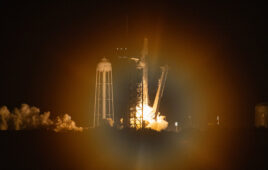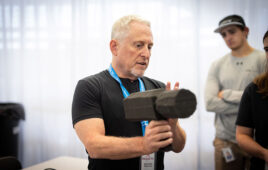 Rosetta’s lander Philae has woken up after seven months in hibernation on the surface of Comet 67P/Churyumov-Gerasimenko.
Rosetta’s lander Philae has woken up after seven months in hibernation on the surface of Comet 67P/Churyumov-Gerasimenko.
The signals were received at ESA’s European Space Operations Centre in Darmstadt at 22:28 CEST on June 13. More than 300 data packets have been analyzed by the teams at the Lander Control Center at the German Aerospace Center (DLR).
“Philae is doing very well: It has an operating temperature of -35ºC and has 24 Watts available,” says DLR Philae Project Manager Dr. Stephan Ulamec. “The lander is ready for operations.”
For 85 seconds Philae “spoke” with its team on ground, via Rosetta, in the first contact since going into hibernation in November.
When analyzing the status data it became clear that Philae also must have been awake earlier: “We have also received historical data – so far, however, the lander had not been able to contact us earlier.”
According to The Guardian, “Philae carries 10 science instruments and teams across Europe must now be champing at the bit to perform more experiments. In the normal run of things, they would have had to wait for another comet landing mission. As Ian Wright, Open University, principal investigator on Philae’s Ptolemy Instrument, pointed out to [The Guardian] recently, such a mission would have been at least 20 years into the future because of the time it takes to plan, build, and test such a highly technical mission.”
The Guardian article further states that Philae’s new target is a primordial comet, which has remained essentially untouched since the solar system formed 4.6 billion years ago. The comet contains “the chemical building blocks of life that would have been present in the interstellar cloud that collapsed to form our planet.”
 Originally, Philae’s task would have been to anchor itself to the comet’s surface during broad daylight. This would have functioned for weeks or even months, up until it overheated when the comet approached the sun in March due to the comet’s approach to the sun. But the landing saw two failures that made Philae bounce to a shady location —a thruster intended to press the lander to the comet failed to fire, and then harpoons that were supposed to anchor it to the ground didn’t trigger. Without sunlight to power it, Philae fell asleep after only about six hours of operation. However, these failures and the long “sleep” allowed scientists to work on the collected data during the spacecraft’s hibernation, analyzing it and developing ways to test their conclusions if Philae did wake up.
Originally, Philae’s task would have been to anchor itself to the comet’s surface during broad daylight. This would have functioned for weeks or even months, up until it overheated when the comet approached the sun in March due to the comet’s approach to the sun. But the landing saw two failures that made Philae bounce to a shady location —a thruster intended to press the lander to the comet failed to fire, and then harpoons that were supposed to anchor it to the ground didn’t trigger. Without sunlight to power it, Philae fell asleep after only about six hours of operation. However, these failures and the long “sleep” allowed scientists to work on the collected data during the spacecraft’s hibernation, analyzing it and developing ways to test their conclusions if Philae did wake up.
Now scientists are waiting for the next contact. There are still more than 8,000 data packets in Philae’s mass memory which will give the DLR team information on what happened to the lander in the past few days on Comet 67P/Churyumov-Gerasimenko.
Rosetta was launched in March 2004, on top of an Ariane 5 G+ rocket. The launch had originally been planned for January 2003, but the Ariane 5 was grounded following the inaugural failure of Arianespace’s new high payload Ariane 5 ECA in December 2002, depriving Rosetta of its launch opportunity to the comet Wirtanen. Rosetta was stored in a cleanroom at Kourou as soon as the decision was made to postpone the launch. Additionally, some of the major hardware items — the High Gain Antenna (HGA), solar arrays, and five of the instruments on the orbiter — were removed. Updated software was installed and all flight systems testing were later revalidated.
 Click here for an ESA video showing Rosetta in the cleanroom.
Click here for an ESA video showing Rosetta in the cleanroom.
Philae shut down on Nov. 15, 2014, at 1:15 CET after being in operation on the comet for about 60 hours. Since March 12, 2015, the communication unit on the Rosetta orbiter was turned on to listen for the lander.
Rosetta and Philae were ready for their biggest challenge yet: landing on Comet 67P/Churyumov-Gerasimenko. As Rosetta bid her lander farewell and sent him to the comet’s surface, the whole world looked on, anxious to see what would happen next. Video circa March 2015
Release Date: June 14, 2015
Source: European Space Agency




